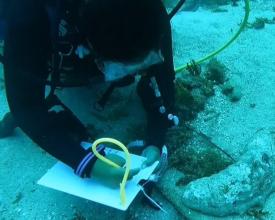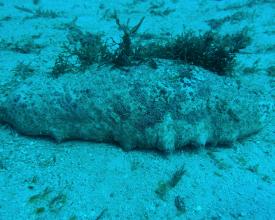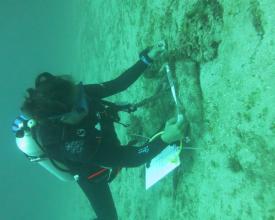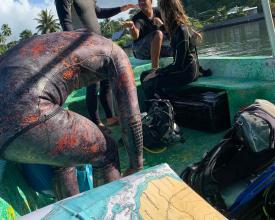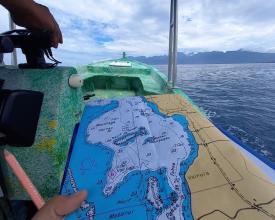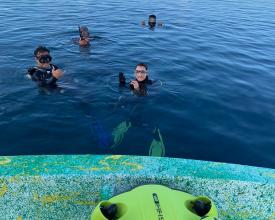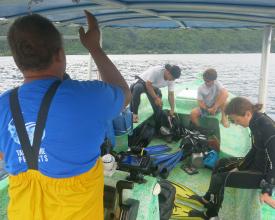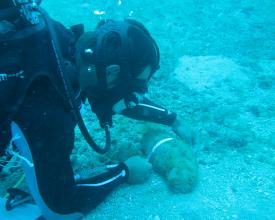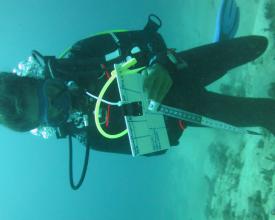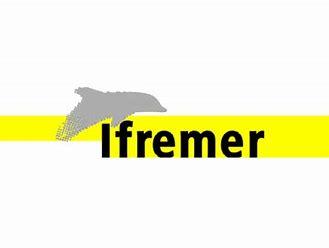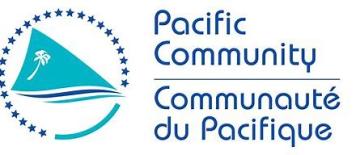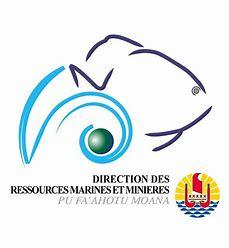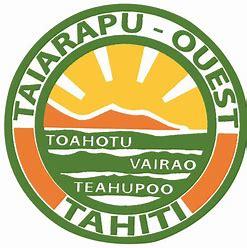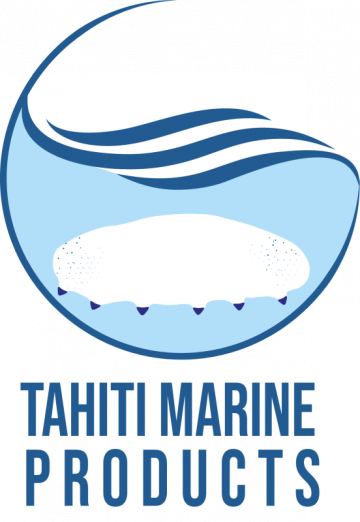
Evaluation of the spatial distribution of a species of sea cucumber (Holothuria fuscogilva) in Vairao lagoon (Tahiti).
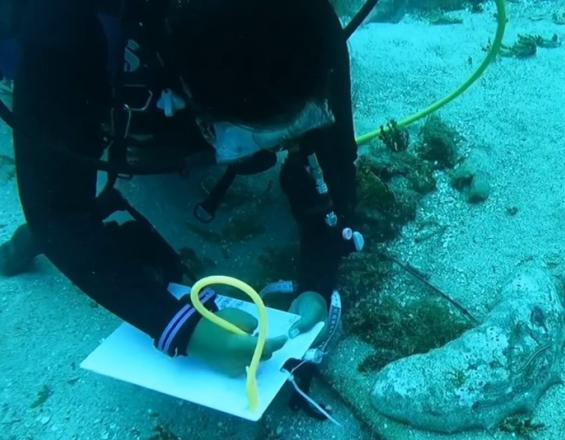
Overexploited for the Asian market, white sea cucumbers(Holothuria fuscogilva) are now recognized as vulnerable (IUCN Red List) and listed in CITES (Appendix II). To participate in the conservation of this species, it is essential to understand the animal's behavior in the wild, its distribution and its stock. The study is taking place in Vairao (southwest coast of Tahiti), where the holothurian hatchery is based. Underwater assessments have identified 10 sites suitable for the aggregation of the species. These sites represent 15% of the lagoon's total surface area and are categorized into 3 types of geomorphological zones: pass approaches, deep channels and the lagoon's inner slope. The results show a density of 53 ind./Ha in the pass approaches, 41 ind./Ha in the channels and 125 ind./Ha on the inner slopes, i.e. an average density of between 65 ind./Ha (low estimate) and 73 ind./Ha (high estimate).
Context
Challenges addressed
-
Census of holothurians H.fuscogilva
-
Establish a database (depth, site, number, etc.)
-
Identification of suitable geomorphological zones
-
Mapping of sites suitable for spawner aggregation
-
Define the spatial distribution of the population
-
Compare data collection methods
-
Training in species identification
Location
Process
Summary of the process
The experience of local fishermen and their knowledge of the field were key factors in the design of this project. Their sharing of knowledge facilitated the implementation of activities. This, in turn, helped us to better assess the risks and define the best data collection method for this study. The training of professional diving teams was also more impactful when delivered by locals.
Building Blocks
Establish a scientific protocol based on the knowledge of local fishermen
When drawing up the study protocol, it is essential to make the most of local experience. Working in partnership with former holothurian fishermen facilitated site selection. Fishermen's testimonies were used to help organize the dives and determine the risks, so as to better anticipate them.
Enabling factors
-
Contact with key players (fishermen, scientific experts, local authorities, etc.).
-
Open-mindedness and recognition of each player's expertise.
-
Networking to organize teams of licensed professional divers according to availability.
-
Mastering the organization of professional scuba dives at great depths (35 m - 45 m).
-
Build a protocol in line with the project and diver safety.
Lesson learned
-
Be a good listener.
-
Reassure the fishermen of our intentions by clearly explaining the interest of our study in their lagoon.
-
Valuing the skills and knowledge of these elders.
-
Establish a relationship of respect and trust between all those involved in the project.
-
Try our best to provide scientific answers to their questions about past observations of the animal's behavior (migration according to lunar phase, etc.).
Resources
Choose the assessment method best suited to the site's characteristics
Holothurian stock assessments have been carried out elsewhere in the world, but the target species, depths and logistical requirements were different. In our case, it was imperative to rework the initial protocol so that it was more adapted to the field, more realistic and more efficient.
Enabling factors
-
Master the specific characteristics of the study site (depth, exposure, etc.).
-
Master the characteristics of different data collection methods.
-
Adapt the protocol to field conditions and scientific needs.
-
Draw up an "Advantages and Disadvantages" table for each method.
-
Compare methods simultaneously on the same site.
-
Carry out the comparison on sites with different characteristics (geomorphological zones).
-
Choose a "control site" where the presence of holothurians has been confirmed.
Lesson learned
-
Carry out reconnaissance dives at selected sites.
-
Test equipment.
-
Carry out simulations at sites representative of the geomorphological zones to be studied.
-
List the depth of all sites.
-
Assess all possible risks.
-
Prioritize diver safety.
-
Have a large network of professional divers.
-
Plan and anticipate.
-
Plan for make-up days in the event of postponement due to unforeseen circumstances (technical problem, bad weather, diver unavailable).
Species identification training
Expert fishermen are encouraged to train professional divers in the identification of the sea cucumber. Fishermen are encouraged to share their old techniques for recognizing the animal (feces tracking, circular search, etc.).
Enabling factors
-
Establish a clear and reliable diving organization.
-
Define a simple, effective protocol.
-
Equip yourself with operational equipment (scuba, tag, underwater camera, etc.).
-
Record as much animal data as possible (measurements, depth, position, behavior, etc.).
-
Always add comments on environmental characteristics (sediment, algae, etc.).
-
Note the weather and abiotic factors (current, swell, etc.) for each dive.
Lesson learned
- Always create a climate of respect and equality between all players.
- Value teamwork.
- Provide the necessary training materials and supports.
- Open discussions to the sharing of field experience.
Efficient underwater data collection
The organization of underwater work must be clear, concise and safe for all divers. A simple but effective protocol will optimize data collection. Equipment must be designed to facilitate note-taking and photography. A reminder of the protocol before each dive is imperative, to remind divers of the purpose of the study and the safety instructions. Divers are also asked to describe the surrounding environment, encouraging them to collect additional data or take photographs of the substrate, slope or other animals encountered, etc.
Enabling factors
-
Establish a clear and reliable diving organization.
-
Define a simple, effective protocol.
-
Equip yourself with operational equipment (scuba, tag, underwater camera, etc.).
-
Record as much animal data as possible (measurements, depth, position, behavior, etc.).
-
Always add comments on environmental characteristics (sediment, algae, etc.).
-
Note the weather and abiotic factors (current, swell, etc.) for each dive.
Lesson learned
- Always have one or two back-up plans.
- Anticipate everything.
- Have a flexible schedule in case of bad weather.
- Have professional divers trained in species identification.
- Have reliable professional divers.
Impacts
- The complementary nature of the field knowledge of former fishermen and the scientific approach of experts. The divers are trained by the fishermen to identify the species and its behavior, while the scientists explain their data collection methods and how to analyze the results. Of the three methods compared, the use of scuba divers was the most effective.
- The aim was to survey white sea cucumbers (measurements, photographs) and to identify and map the geomorphological zones in the Vairao lagoon that are suitable for this species. The results show an estimated total number of between 3250 and 3650 individuals.
- As part of our aquaculture production, 50 spawners from the lagoon on the same coast of the island are used for spawning. Site identification ensures efficient broodstock renewal operations (no sacrifices are made), enabling sustainable aquaculture (hatchery/juvenile production) of H.fuscogilva and promoting an activity that is not detrimental to the natural resource. The development of sustainable aquaculture can be a tool for preserving the species by reseeding juveniles in overexploited lagoons.
Beneficiaries
The main beneficiaries are SCA Tahiti Marine Products, the Marine Resources Department, Ifremer, the FAME unit of the Pacific Community (SPC), local fishermen and divers involved in the project, and the commune of West Taiarapu.
Sustainable Development Goals
Story
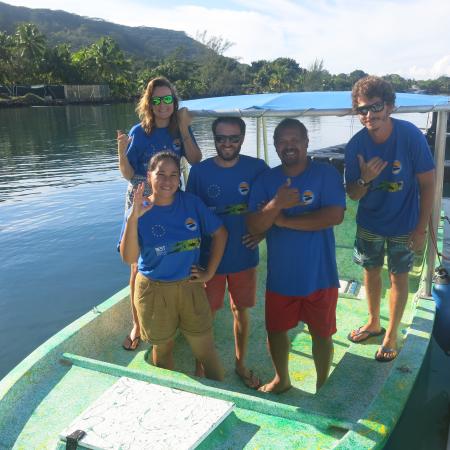
The most important lesson learned from this project was the importance of incorporating the knowledge of former sea cucumber fishermen into the development of the protocol.
Originally from Vairao, Perehaina has been fishing since a very young age. His mastery of fishing techniques ranges from trolling to underwater fishing. From 2008 to 2012, he took part in holothurian fishing campaigns in the Vairao lagoon. The mammary sea cucumbers were a favorite, as they are highly valued in Asia. Through these years of fishing, Perehaina has become an expert at identifying the species, characterizing the geomorphological zones conducive to their aggregation and harvesting techniques.
While we were working on the scientific method, it soon became clear that to optimize the study, it was vital to integrate the knowledge of local fishermen. So I asked Perehaina for help. He agreed to identify on my A1 paper SHOM chart the sites where, ten years earlier, he had fished for white sea cucumbers. He also told me that, depending on the period, the sea cucumbers were either concentrated around the pass or in the deep channels inside the lagoon. We therefore hypothesized a migration according to spawning periods and the lunar phase. We tried to adapt the protocol to verify this phenomenon, but the results were not sufficient to be statistically viable. Nevertheless, we must direct our next projects towards the study of this migratory trend to better understand and preserve the species.
Thanks to his knowledge of the bathymetry of each site, the strength of currents and their exposure during swell periods, Perehaina was invaluable during the risk assessment prior to the launch of the study. He took part in every dive day, while continually sharing his knowledge with professional divers.
In my opinion, the greatest success of this project was the inclusion of local expertise and the sharing of knowledge between all those involved in the field.
